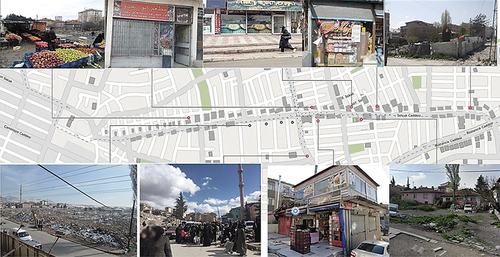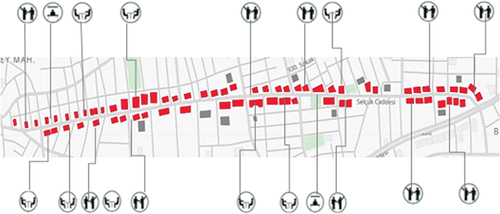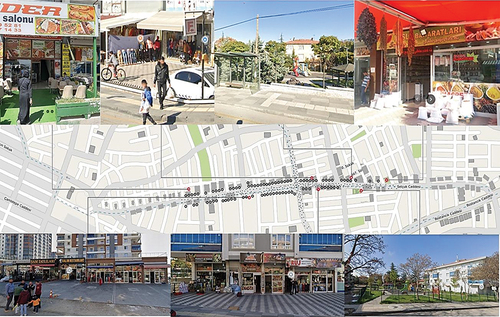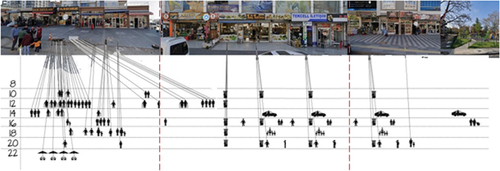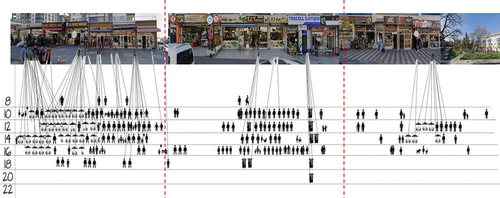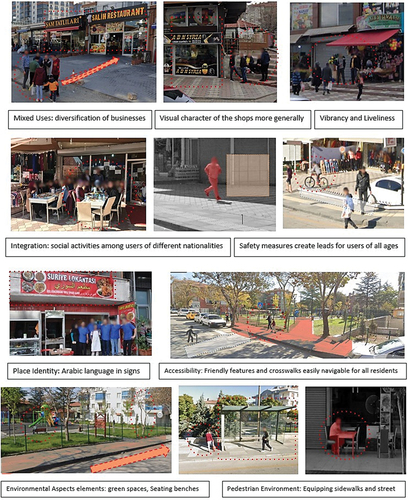ABSTRACT
Türkiye has recently welcomed a significant number of Syrian refugees into its cities and camps. This research hypothesizes that with access to appropriate resources, refugees can leverage their cultural backgrounds, prior professional experiences, and economic skills to enhance social integration and contribute positively to their new communities. The study focuses on the urban characteristics and sustainability of mixed streets, believed to influence social life in refugee neighborhoods, ultimately promoting social justice. The research methodology involves a literature review on sustainability and social development in mixed streets. It also includes a case study of Selçuk Street in Ankara, tracking its development since the arrival of Syrian refugees. Behavioral observations, data recording, documentation, and mapping of refugee activities are used to visualize social interactions within the street. The central question is whether urban development and the sustainability of mixed streets can effectively promote social justice and the integration of refugees into their new societies. This research provides insights for academics and urban designers, guiding future efforts to foster integration and coexistence in these evolving communities.
1. Introduction
There is an ongoing debate regarding the consequences of hosting a large number of refugees, particularly in terms of their impact on the economy, society, and politics. This debate has gained significant attention with the arrival of a substantial number of Syrian refugees in Europe. In 2017, the global number of forcibly displaced people reached 68.5 million, with 25.4 million living outside their country of origin and 40 million internally displaced. Furthermore, there were 3 million pending cases related to displacement (UNHCR Citation2018). It is important to note that the majority of refugees, approximately 85 percent, reside in developing countries.
One country that has experienced a significant influx of Syrian refugees is Turkey. The rough count of Syrian refugee seekers in Turkey reached 3.5 million, they have established vibrant residential societies and have become a reliable part of the labor force, contributing to the economic and manufacturing sectors (Altaema and Hatipoğlu Citation2023).
The main goal of this research is to produce a comprehensive methodological way of measurement that estimates the role of sustainable mixed streets and public openings as catalysts for urban change, socio-economic contribution, and the integration of refuge seekers into host societies (UNESCO Citation2016). The framework relies on the synthesis of previous research and identifies key points regarding sustainability throughout various dimensions, including the flow of urban transformations, the integration of commercial and social activities, and the importance of environmental stewardship. Using an analysis of these methods and their effect on social sustainability the research thrives to provide important insights and applicable recommendations for urban designers and decision-makers, fostering harmonious co-existence among diverse communities.
The research uses a wholistic methodology that goes into the actions facilitating the seamless integration of refuge seekers into mixed streets and public openings in Türkiye. The main objective is to identify advantages and disadvantages by creating a modular structure that links conceptual models to an overall dimensional framework. This framework is applied through a quantitative evaluation of the levels of sustainability embedded in the streets. The empirical test involves meticulous documentation of refugee activities, revealing their effect on the inter-connected social fabric included in these streets.
The rigorous process of this research suggests a plethora of insights that culminate in a compendium of recommendations. These recommendations are designed to strengthen the public bubble, preserve the urban identity, improve the quality of life for refuge seekers’ communities, and effectively regulate informal actions that may slow down integration and harmonious co-existence among diverse groups. The ultimate aim is to create a sustainable and accepting environment that benefits both refuge seekers and the host society alike.
In conclusion, the scholarly endeavor focuses on elucidating the role of sustainable mixed streets and public spaces in facilitating the integration of refugees and improving their lives in host societies, with a specific emphasis on social activities and urban transformations. The research is conducted in an academically rigorous manner and aims to provide practical and scientific insights.
2. Fostering refugee integration through sustainable mixed streets
Sustainable development encompasses various dimensions, including social sustainability, which focuses on community well-being, empowerment, and improved quality of life. In the context of urban areas, the integration of refugees within mixed-use streets is of paramount importance. This integration not only contributes to the social sustainability of the city but also empowers refugees through education, community inclusion, and economic participation. By creating sustainable mixed streets, cities can foster an inclusive and cohesive society that benefits both current residents and newcomers seeking refuge.
Socio-cultural inclusion can be defined as the process of improving the opportunities and participation of individuals and groups in society, particularly those who are disadvantaged based on their identity (World Bank Citation2017). In the context of public space and streets, socio-cultural inclusion plays a crucial role in addressing socio-spatial segregation at the neighborhood level, especially for immigrant communities.
2.1. The spatial character of public spaces
Each public space has a distinct spatial character shaped by factors such as proportion, scale, interplay of elements, color, texture, furnishings, and activities. Understanding and treating these spaces as dynamic physical entities with multifaceted attributes are crucial aspects (Fard Citation2014). Public spaces must establish connections with the central urban pillars: the life activities of users, the spatial context within which the space exists, and the surrounding structures that frame the space, collectively contributing to the overall public space ambiance (Council Citation2007).
Public spaces have the potential to promote social inclusion in various ways at the neighborhood level. First and foremost, public spaces provide visibility and recognition for the cultural aspects of immigrants, allowing them to be noticed and acknowledged by the wider community (Sezer and Fernandez Maldonado Citation2017). By sharing the same physical space, urban residents can engage with and appreciate the diversity arising from cultural characteristics, age, gender, economic status, ethnicity, and beliefs (Amin Citation2008).
Public spaces create opportunities for social, economic, and cultural exchanges among different people. Chance encounters in these spaces contribute to the dynamic public life of the city, which can be observed, studied, and mapped (Lesan Citation2015). These interactions enable individuals to develop a deeper understanding of each other’s backgrounds and foster a sense of social cohesion. Look to
Figure 1. Mixed street characteristics (Fouad Citation2019).
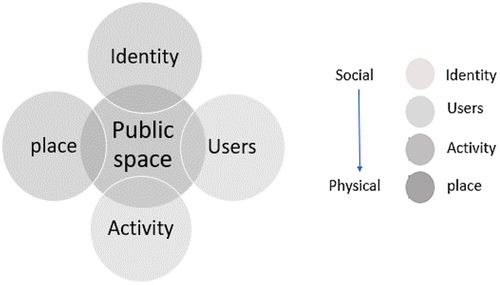
2.2. The significance of vibrant streets
A vibrant street bustling with people and activity holds more significance than a dormant one with little foot traffic. The presence of people fosters a sense of security and emphasizes the role of streets in facilitating social interactions (Efroymson et al. Citation2009). Commercial streets, in particular, serve as hubs for diverse shopping experiences, services, and conveniences and stimulate economic growth (Planning Council, Citation2012).
2.3. The functions of urban commercial streets
Urban commercial streets fulfill two primary functions: “Place” and “Accessible Link.” As an Accessible Link, a street functions as a conduit for movement, seamlessly integrating into the urban transportation network (Fouad Citation2019). Conversely, as a Place, an urban commercial street is a destination in itself, where individuals engage in various activities like shopping, conversing, waiting, resting, and working. These pedestrians are sensitive to noise, air pollution, and traffic congestion, which hinder movement and impact the overall street experience (Jones, Marshall, and Boujenko Citation2008).
The role of streets in promoting social and cultural integration can be seen through the services and activities they provide. The commercial street plays a crucial role in accommodating public life, more than other public spaces. It serves as a stage that connects the infrastructure of different activities (Sinnett et al. Citation2011) for example, shopping streets act as gathering points for both residents and visitors, and they contribute greatly to people’s mental maps (Arkaraprasertkul Citation2018), consequently, they enhance interaction and a sense of community. The services and activities on the street can vary depending on its location, from city centers with diverse visitors to suburbs that cater primarily to residents (Beckhoven and Kempen Citation2003). These differences contribute to the public life on the street, and range from a more general atmosphere to a more private one.
The diversity and vitality of public spaces are closely connected. Diversity refers to the mix of people and functions in a particular area, which can be observed and measured at different levels. Policies and planning regulations often aim to promote diversity through a mix of land uses and population groups, making cities more attractive and inclusive Vitality (Naylor and Florida Citation2003), on the other hand, is enhanced by diversity as it encourages interactions among different urban segments. Immigrant amenities, such as shops, restaurants, and communal spaces, contribute to both diversity and vitality by showcasing distinct languages, products, cuisines, and practices. These amenities enrich public life by attracting diverse individuals and fostering cultural exchanges (Kloosterman, Van der Leun, and Rath Citation1998)
2.4. Principles for Sustainable Commercial Streets
Previous studies in the field of Urban Design and Sustainability have consistently linked the concept of Sustainable Streets to various important pillars. Several theorists have established connections between these pillars and the achievement of sustainable streets. Notable researchers such as Anonymous (Council Citation2007; Jacobs Citation1992; Lynch Citation1960) have contributed to the discourse on this topic. Building upon their work, the following points outline key concepts that form a negotiation management strategy for Commercial Streets to attain sustainability:
Cultivating Identity: Creating a unique sense of place that instills pride and belonging.
Guiding Development Trajectory: Shaping current and future developments to align with sustainability goals and integrate infrastructure into the environment.
Enhancing Physical Character: Transforming ordinary spaces into inviting environments that captivate all who encounter them.
Promoting Social Integration: Encouraging social cohesion, inclusivity, and connections within the community.
Establishing Connected Routes: Creating safe and easy movement pathways for pedestrians and cyclists.
Preserving and Enriching Biodiversity: Safeguarding green spaces and fostering thriving ecosystems.
Reinforcing Green Infrastructure: Reintroducing green infrastructure and ecosystem services to improve the urban environment.
Boosting Economic Activity: Enhancing the commercial potential for economic growth and opportunities.
Nurturing Cultural and Recreational Activities: Fostering a vibrant cultural and recreational scene to strengthen community bonds.
Honoring Historical and Cultural Significance: Preserving the area’s historical, cultural, and archaeological value, maintaining its distinct identity and heritage.
Incorporating these principles into a sustainable development plan for mixed streets not only revitalizes frustrated spaces but also creates thriving hubs of activity that cater to the needs of all, including refugees seeking to be part of the community (Landau et al., Citation2020). By intertwining these concepts with urban design, a transformation occurs that serves immediate urban needs and lays the foundation for future generations, creating purposeful and enduring mixed public spaces. This inclusive approach fosters social cohesion, empowers refugees, and enriches the collective fabric of the city (Aelbrecht, Stevens, and Nisha Citation2018).
To understand sustainable streets, it is necessary to integrate diverse studies and concepts. A comprehensive reference set, which includes a wide range of literature and previous theoretical research, is essential for deriving a set of key concepts. Mehta put forward a foundational framework for the study of neighborhood commercial streets (Mehta Citation2016). This framework identifies three main characteristics of streets: physical characteristics, land-use patterns, and social activities. These attributes, along with users’ perceptions affected by associations, backgrounds, and the presence of activities, collectively make up the overall perceived quality of the street.
The study further classifies the resulting quality into six categories, see which are consistent with the theories of human needs proposed by Maslow and Steele. These categories include a range of static, sustainable, ongoing, and social activities that are influenced by the perceived quality of the street (Fouad Citation2019). It is important to note that this typology provides a valuable lens for examining the multidimensional aspects of sustainable streets, taking into account the different needs and activities that they can accommodate and that subsequently lead to co-social coexistence between local populations and refugee groups.
Table 1. Mixed street sustainability criteria in the literature (made by authors).
3. Methodology
3.1. Research objective
The primary objective of this study is to assess the impact of mixed street sustainability on the socio-cultural inclusion of related refugee groups. Specifically, the study focuses on a mixed commercial street catering to Syrian refugees. It explores how the physical characteristics of these commercial streets can enhance, influence, or mitigate the social life of neighborhoods, contributing to a coexistent social environment.
3.2. Syrian population in Turkey
Syrian institutions on these streets exhibit significantly higher visibility compared to other ethnic groups. This heightened visibility can be attributed to the fact that Syrian refugees constitute the largest refugee group in Turkey, with a population of approximately 3.5 million individuals. Moreover, Syrians in Turkey demonstrate a high degree of entrepreneurial activity compared to other demographic groups.
3.3. Study location
The study centers on Selçuk Street in Önder Ankara, an area where a significant portion of Syrian refugees settled, particularly within the Altındağ municipality in northeastern Ankara, near the Siteler factory area. This choice of location was influenced by the availability of affordable housing in Önder, which is near the Siteler factories where many refugees are employed. Additionally, refugees began residing in the Ulubey neighborhood adjacent to Önder. Within Önder, Selçuk Street boasts the highest concentration of Syrian-run shops, leading to its colloquial nickname Küçük Halep “Little Aleppo” (Temel Citation2018).
4. Research methodology: the investigation is carried out in three main phases
Phase 1: Description of Street Transformation: The study commences by describing the transformation processes in the street and the surrounding neighborhood, with a specific focus on the period from 2012 to 2023.
Phase 2: Street Public Space Analysis: The investigation analyzes public spaces in 2012 and 2023 on Selçuk Street. This analysis includes examining the physical condition of the streets and how shops and amenities are located and visible on the street. It also looks at how people use these facilities and how their usage patterns change throughout the day through:
People’s activities: This involved studying the social life of commercial streets through behavioral observations conducted over three months. Observations were made on five days each week, including weekdays and weekends. Short, one-minute videos were recorded at three-hour intervals from 9:00 AM to 10:00 PM. These videos were translated into street maps, documenting the nature of activities, their locations, the number of participants, and their nationalities using relevant pictograms.
The physical environment: This phase involved investigating how the built structure of the streets influences people’s gathering, coexistence, and identity manifestation, ultimately affecting their integration.
Phase 3: Discussion and Analysis of the Results: The results obtained from the previous two phases were discussed, and these findings were correlated with the social and urban sustainability criteria outlined in the literature. The study also assessed the extent of their impact and role in the social integration and coexistence of Syrian refugees within the urban context.
5. Historical development and urban transformation of Önder neighborhood
The Önder neighborhood is located in the Altındağ district see , which has the highest number of Syrian refugees compared to other districts in Ankara. It is a slum neighborhood near the Siteler Small Furniture Industry area. The neighborhood’s population has been increasing due to the influx of Syrian refugees in recent years. The Önder neighborhood is one of the 37 neighborhoods in the Altındağ district (Önder Erdem Citation2011). The development of the Önder neighborhood began around the 1950s, coinciding with the growth of the Siteler Small Scale Furniture Industry. Before the 1950s, Ankara’s development was centered around the old city of Ulus, and squatter settlements emerged primarily in Ulus and its vicinity (Şenyapili Citation2004).
In the 1940s, there was an increase in migration from rural areas to Ankara, which resulted in squatter settlements populated by the migrant workforce. Önder neighborhood was part of the third wave of squatter development in the 1940s. In the 1980s, rehabilitation processes began in squatter areas, including the Önder neighborhood, due to amnesty laws. These laws aimed to legalize unlicensed constructions and transform squatter settlements into apartment complexes. While some squatter areas quickly transformed, others located in less favorable locations struggled due to various reasons (Işık and Melih Citation2001). In 2011, transnational migration from Syria to Turkey started, and the Önder neighborhood became an important refuge for Syrian refugees, partly due to its proximity to the Siteler Industry Area. Since 2013, urban transformation operations have been taking place in the Önder neighborhood. The area was designated as a high-risk zone and demolished in 2015. Specific plans for the neighborhood’s future remain unclear, given the evolving nature of urban transformation policies in Turkey (Sadioğlu, Tiryaki, and Korkmaz Citation2016).
Overall, the Önder neighborhood’s historical development and urban transformation processes have been influenced by demographic changes, industrial growth, migration patterns, and government policies. The presence of Syrian refugees has had a significant impact on the neighborhood, contributing to ongoing changes and transformations (Eraydin Citation2017).
Phase 1: Description of Street Transformation,
6. Study area (Selçuk street) 2012
In the early years of the influx of Syrian refugees, Selçuk Street, located in the Önder district of Ankara, carried a distinctive atmosphere of tension and exhaustion. This condition has been amplified by the partial destruction and abandonment of buildings in the area, mainly because the neighborhood was originally slated for redevelopment. Altındağ Local Municipality declared Önder an “urban renewal area” in July 2015. By 2017, a large number of buildings, about 2,150, had been demolished, and about 6,000 residents had moved to other areas (KILIÇ, BERBER, and Çetİn Citation2015). This process of urban transformation destabilized the neighborhood, affecting both long-time residents and incoming refugees (Kavas and Kadkoy Citation2018).
Syrian refugees, spurred on by the economic opportunities in the nearby small industrial area of Siteler, have increasingly chosen to move to Ulubey and Önder in search of affordable housing. Landlords in these areas have often proven more open to renting to refugees than other neighborhoods, given the shifting dynamics brought about by urban renewal efforts (Penbecioğlu Citation2022).
Despite the challenges and uncertainties, Selçuk Street developed into a neighborhood inhabited mainly by Syrians, followed by Iraqis and other foreign residents. Syrians from different backgrounds, especially from Aleppo, made up a large percentage of the population. This diversity contributed to creating a sense of community and shared identity among the residents, linked by their shared experiences as refugees. The spread of the Arabic language and culture has facilitated bonds and interactions among the diverse population, enhancing a sense of belonging (Temel and Kahraman Citation2019).
Many of the refugees found solace in their new neighborhoods. Despite the economic challenges and lack of legal status, there was a remarkable sense of communalism and ownership among them. Refugees have taken the initiative to open their businesses, from shops to restaurants, often in partnership with Turkish individuals sympathetic to their plight. The Turkish partners will officially register these companies in their names due to the legal restrictions Syrian entrepreneurs face (Subaşı Citation2019).
Signage for refugee-owned businesses mostly featured Arabic calligraphy (Temel Citation2018), reflecting their cultural identity (Temel and Kahraman Citation2019), and their product offerings included a mix of Syrian and Turkish goods see . Notably, some Syrian products are actually manufactured in Turkey, highlighting the subtle integration of refugees into the local economy (Dell Citation2020). Wealthy Syrian refugees set up factories in Turkey, contributing to the local production scene.
Some questioned the legitimacy of Syrian stores, but the situation is complex. Many refugee shopkeepers claim to pay taxes and report sales through Turkish partners, operating in a legal gray area. These businesses often fluctuate between formal and informal status, with various individual situations. Refugee entrepreneurs emphasized their limited options and efforts to comply with rules despite challenges like high living costs (Abdulhadi Citation2019). Despite the economic hardship and uncertain legal status, the resilience of the Syrian refugee community has been evident in their efforts to establish businesses and build lives in Önder. These individuals displayed resourcefulness and determination, embodying a sense of empowerment despite the obstacles they faced in a rapidly changing urban landscape.
6.1. (Selçuk street) 2023
In 2021, Selçuk experienced significant diversity and transformation compared to the previous years, particularly noticeable on the eastern and western sides of the street. The number of Syrian shops reached over 100, with the western side undergoing more prominent changes.
Commercial establishments in Selçuk included various types of businesses. There were 50 daily food stores, including butchers, groceries, and bakeries. Additionally, there were 12 restaurants, offering sweets, snacks, and regular meals. Service establishments comprised 30 businesses, such as tailors, clothing and shoe repair shops, car repair shops, hair and beauty salons, travel agencies, legal offices, telephone and electronics stores, as well as car offices. The remaining 42 establishments were classified as other types of shops, including those dealing in clothing, furniture, lighting, kitchen appliances, and more. The community establishments on the street included six restaurants with traditional sessions and 12 organizations, encompassing religious and educational institutions see . The distribution of these facilities showed that approximately 85% of Turkish establishments were located on the main shopping streets, while the remaining 15% were situated on side streets.
The distinctive feature of diversification in Selçuk was the significant presence of businesses owned by Syrian refugees. This can be attributed to the settlement of a large number of Syrian refugees in the neighborhood since 2011. illustrates the functions of these shops, with Syrian establishments marked with black circles, and the large numbers of street users at peak time.
The eastern and western sides of Selçuk differed significantly in terms of the types of shops, especially those owned by Syrians. The western side featured a vibrant modern street market that emerged in early 2019, attracting visitors from across the city, particularly the Arab community. This market offered traditional food products, embodying the oriental spirit and serving as a symbol of memory and Arab culture. It also included affordable clothing stores, a mix of chain stores, oriental food restaurants, jewelry stores, and car offices. On the other hand, the eastern side of Selçuk was characterized by independent neighborhood shops catering to the daily needs of the local population. These included grocery stores, bakeries, small coffee shops, clothing repair shops, travel agencies, and hair salons. This section housed a significant number of Turkish shops.
Syrian shops on Selçuk Street had distinct visual characteristics that made them stand out. Many prominently displayed their names on large banners, advertisements, and billboards in the Turkish language, along with a smaller portion in Arabic. This displayed cultural integration with the host community. Additionally, these shops often showcased their products in vibrant display windows that extended to the sidewalk, giving them an inviting and attractive appearance. These visual elements played a role in attracting the Arab community, transforming the area from a commercial non-existence to a bustling hub. Syrian restaurants, in contrast, presented their products with a clear Syrian identity, showcasing popular foods and traditional presentation methods. This visual clarity contributed to attracting attention. shows the street state.
7. Street public space analysis
The liveliness of Selçuk Street was closely tied to the operating hours on the west side. The market operated from 9 am to 8 pm, and most surrounding shops adhered to similar working hours. During these open hours, Selçuk became a thriving center, attracting people of all ages and genders, both locals and visitors. Various activities like sitting, standing, observing, gathering, and socializing added vibrancy to the street, especially around the Taxi Önder intersection. However, after 9 p.m., when most shops closed (except for some services), street activity significantly diminished. These observations highlight the diversity and transformation in Selçuk 2021, marked by the presence of Syrian businesses, the development of a bustling street market, and the integration of Turkish and Syrian cultures within the local community.
The primary method used to study daily life in public spaces involves direct and covert observation of human behavior, with a focus on how these behaviors relate to the surrounding environment (Gehl and Svarre Citation2013). By observing people’s actions, we can gain valuable insights into why certain spaces are used more frequently than others, and how these activities are affected by the physical properties of the environment (Stevens, Citation2014)
To collect the data, we conducted case studies and confidential observations of individuals in their natural environments, without directly interacting with them or manipulating the environment. These observations were made over a period from early March to early May of 2022, during days with similar weather conditions. The case study selected for this research is approximately 860 meters long and has been divided into three distinct parts how as appear in 60-minute continuous video recording was conducted in each segment, from 8 a.m. to 10 p.m. Next, we thoroughly analyzed these short video clips and organized the data into visual tables. These tables documented various aspects of the activities observed, including the type of activities, their spatial distribution, the timing of these activities, and their relevance to public street use.
The presence of various stores on the western side of the street had a significant impact on user density and activities. This area experienced the highest level of activity between 09:00 am and 10:00 am we notice this in , coinciding with the working hours of the surrounding shops. As these shops closed after the market hours, street traffic decreased, affecting sidewalk activities like sitting, gathering, and chatting. User density and activities varied across the western, central, and eastern sides of the street, as shown in .
These differences in user activities were observed both during the day and at night. The extended working hours of Syrian cafes, restaurants, and eateries contributed to a vibrant street life, especially during weekends. The area attracted Arab visitors who were interested in purchasing Syrian products and experiencing the local identity and culture. illustrates the user density during weekends. Shops and restaurants typically opened in the morning and experienced peak activity around noon. This resulted in people gathering and conversing in front of these establishments, fostering a sense of coexistence and blending. Cafes and restaurants played a crucial role in facilitating socialization between Turkish and Syrian men, as well as visitors from outside the region. These establishments provided a space for exchanging daily news, job opportunities, and housing information. A similar dynamic unfolded for Syrian women in food shops. These shops offered halal products and primarily attracted women, especially housewives who preferred buying groceries daily. These establishments served as social hubs where women would share the latest news or discuss their plans for the day.
The inclusion of street furniture and modest green spaces as part of the urban development plan greatly facilitated these social exchanges. These elements encouraged direct and indirect communication with others, allowing the Syrians to integrate into their new society without erasing their memory and culture. Commercially, the sidewalk extends on both sides of the street and along it, but pedestrians are not welcome due to the overcrowding and oldness of the street, so there is no trace of civil functions in it. By observation and scrutiny, we found the street commercially, socially, and vitally active, serving the residents of the region in addition
8. Finding
The primary methodology used in this study is to examine different concepts related to the sustainable urban development of mixed streets and their impact on the socio-cultural integration of refugees. The research focuses on the noticeable changes in Selçuk Street between 2012 and 2023 while studying the diversity and dynamism of commercial and service shops in it. Diversity refers to the variety of store types, their distinctive visual characteristics, and their impact on enhancing social relations (Sezer, Citation2018). On the other hand, the dynamic relates to the use of the street by various stakeholders including Syrian refugees, Turkish hosts, and visitors, as well as the varying density of users at different times of the day.
During the study period, Selçuk Street witnessed a great transformation. Many existing businesses have been opened or converted into different establishments, which has led to a significant increase in trendy cafes and restaurants. The street landscape has also undergone significant changes due to new street design elements, including the introduction of proportionate parks, wider sidewalks, and additional street furniture and gardens.
These transformations have increased the diversity and vitality of Selçuk Street. New services and shops, especially cafes and restaurants, replaced many of the existing businesses, the majority of which were originally Turkish-owned. However, this shift led to changes such as the renaming of shops from Arabic to Turkish and changes in their visual appearance, which eroded their cultural distinctiveness and made them resemble more general establishments.
In terms of liveliness, Selçuk Street witnessed a surge of activity, especially during the weekends, which was facilitated by the wide sidewalks and the presence of more green spaces. The extended opening hours of cafes and restaurants have brought the street to life, attracting new audiences from all over Ankara.
The proportion of different types of use can be directly related to the nature of the street. The diverse use of retail stores attracts users of different age groups and different cultures, thus sharing each other’s culture (Cihanger Ribeiro Citation2022). It is worth noting that urban renewal efforts have primarily revitalized the commercial sector rather than leading to significant demographic changes. Despite these changes, the existing shops and restaurants have managed to maintain their unique character.
Selçuk Street has undergone a remarkable transformation in recent years, driven by urban redevelopment, increased cultural diversity, and evolving dynamics. An assessment of whether Selçuk Street embodies the six key sustainability factors while considering their impact on social justice and refugee inclusion is necessary for a comprehensive assessment see .
A street is a public space that attracts different groups of people for different purposes. Accessibility for commuters destined for the Siteler industrial area, pedestrian street vendors doing business, and everyday users creates a vibrant street atmosphere. The encounter with everyday life presents a dialectical perspective on social and economic reality (Farahani, Mirjana, and Ali Citation2015). The continuous production of economic activities in the street reflects the diversity and potential of social dynamics that enhance coexistence. The continuous production of economic activities in the street reflects the diversity and potential of social dynamics that can create an environment suitable for coexistence, starting with the processes of re-employing places and activating them economically. For example, the choice of location and public participation in the places of daily activities in the streets reshapes the pattern of the area, and the revitalization of spaces and economic revitalization contribute to the reconfiguration of the area and the informal economic sector (Michel Citation1994). The intertwining of economic relations and social life contributes to the formation of a cohesive and self-regulating society (Kim Citation2016). Signs play a role in redefining the “buying effect” and recreating the social aspect of the street with a lively and visually appealing atmosphere (Hall and Datta Citation2010). Personal items such as chairs, plant pots, and decorative front yards add an artistic touch to the street ((Habraken Citation2000). Local styles and architectural elements create a sense of community and contribute to the social fabric of the street. These patterns extracted from the street illustrate how the urban space reflects the social practices and bodily adjustments made by residents, reinforcing a sense of belonging. Street urbanization and the holistic elements of sustainability are closely intertwined with these developments. Refugees can take advantage of the mixed commercial street to meet their needs, promoting recognition and informal interactions with other community members. In conclusion, through this study, it is clear that the constituents of street sustainability play a critical role in facilitating the integration of refugees, as they provide opportunities for social interaction and informal participation within the wider community (Altaema and Hatipoğlu Citation2023).
9. Conclusion
From this perspective, the research findings demonstrate that the urban transformation processes undertaken in Selçuk Street have positively influenced the social and spatial inclusion of Syrian refugees. As the neighborhood’s demographics changed and commercial activities developed, there was a notable increase in Syrian-owned establishments and shops. This growth has made the presence of Syrian-owned establishments and shops more prominent in the public life of the street. This has had a distinct cultural influence, setting the area apart from its previous state. The rise in commercial and service activities has also created more opportunities for informal encounters and social interactions in daily life.
Social and commercial activities have influenced social behavior in the streets, creating new spaces. These spaces allow people to change urban plans and transform physical space into everyday spaces of coexistence, in which they express their culture and ideas and create opportunities for coexistence while searching for new opportunities in life (Farahani, Mirjana, and Ali Citation2015).
Furthermore, Selçuk Street has transformed from an area primarily inhabited by workers into a distinctive commercial street catering not only to the local market but also to Arab visitors from all over Ankara. The proximity of the street to the industrial area has a significant impact on the objectives and characteristics of urban renewal processes. These, in turn, affect the ongoing presence of refugees and their ability to establish themselves in public spaces. Economic forces often prioritize profitable projects in central neighborhoods, overlooking the social needs of the residents. This highlights the crucial role of developers, urban planners, and designers in recognizing the unique contributions of users to economic and social life and incorporating their capabilities and needs into development plans that aim to enhance the social inclusion of these communities.
Moreover, this study introduces the impact of refugee groups on commercial streets as a novel perspective for examining sustainable integration at both the social and urban levels, shedding light on the intersection of urban planning, social theory, and the integration of refugee communities. The research underscores the significance of the urban environment, particularly streets and public spaces, in facilitating social inclusion. Additionally, it highlights the potential for further empirical analyses of social inclusion utilizing the concepts of social and urban sustainability.
Disclosure statement
No potential conflict of interest was reported by the author(s).
Correction Statement
This article has been republished with minor changes. These changes do not impact the academic content of the article.
References
- Abdulhadi, N. 2019. The Challenges of Sustainable Construction in Syria as A Case Study [Master thesis, Near East University]. http://docs.neu.edu.tr/library/6814042254.pdf.
- Aelbrecht, P., Q. Stevens, and B. Nisha. 2018. “Introduction from Mixing with Strangers to Collective Placemaking: Existing Theories, Policies and Practices Around Social Cohesion in Public Space Design.” April Public Space Design and Social Cohesion: An International Comparison 2021:1–33. https://www.researchgate.net/publication/329423939.
- Altaema, M., and H. K. Hatipoğlu. 2023. “The Socio-Economic Impact of the Commercial Street in Achieving Sustainability for Refugees in the Host Community.” Current Urban Studies 11 (2): 255–268. https://doi.org/10.4236/cus.2023.112013.
- Amin, A. 2008. “Collective Culture and Urban Public Space.” City 12 (1): 5–24. https://doi.org/10.1080/13604810801933495.
- Arkaraprasertkul, N. 2018. “Review of Global Cities, Local Streets: Everyday Diversity from New York to Shanghai.” Journal of World-Systems Research 24 (1): 240–246. https://doi.org/10.5195/jwsr.2018.795.
- Beckhoven, E. V., and R. V. Kempen. 2003. “Social effects of urban restructuring: a case study in Amsterdam and Utrecht, the Netherlands.” Housing Studies 18 (6): 37–41.
- Bennetts, H., V. Soebarto, S. Oakley, and P. Babie. 2017. “Feeling Safe and Comfortable in the Urban Environment.” Journal of Urbanism 10 (4): 401–421. https://doi.org/10.1080/17549175.2017.1310746.
- Cihanger Ribeiro, D. 2022. “The Form of Social Life: Seeing Beyond Informality in Emergent Design Qualities, the Case of Yüksel Street in Ankara.” Journal of Urban Design: 1–19. https://doi.org/10.1080/13574809.2022.2091983.
- Council. (2007). Plan Abu Dhabi 2030 Urban: Structure Framework Plan. Plan Abu Dhabi 2030, 48–186. http://www.upc.gov.ae/abu-dhabi-2030.aspx?lang=en-US%5Cnhttp://www.upc.gov.ae/template/upc/pdf/Capital-2030-en.pdf.
- Dell, A. C. 2020. Precarity and the Sustainability of Livelihoods. October. https://static1.squarespace.com/static/599720dc59cc68c3683049bc/t/5f88a82991c7057e866f0681/1602791467148/RIT+Report+Ankara+Turkey.pdf.
- Efroymson, D., T. Thi, K. Thanh, H. Pham, T. Ha, and L. Jones 2009. Public Spaces: How They Humanize Cities HealthBridge -WBB Trust. September. https://www.researchgate.net/publication/281834385_Public_Spaces_How_they_humanize_cities.
- Eraydin, G. 2017. MIGRATION, SETTLEMENT AND DAILY LIFE PATTERNS OF SYRIAN URBAN REFUGEES THROUGH TIME GEOGRAPHY: A CASE OF ONDER NEIGHBORHOOD, ANKARA July).
- Erdem, Ö. 2011. Spatiality of Gender Oppression: The Case of Siteler, Altındağ: A thesis in Urban Policy Planning and Local Governments.
- Farahani, L., L. Mirjana, and S. Ali 2015. The Social Life of Commercial Streets. 8th Making Cities Liveable Conference, July, 95–132. https://doi.org/10.5749/minnesota/9780816670949.003.0004
- Fard, H. R. 2014. Evaluating Spatial Behavior in the Urban Public Space of Kadıköy Square. 2nd International Conference on Architecture and Urban Design, Epoka University /Albania, June 2014. MIT Press. 1–12.
- Fouad, M. 2019. “Towards Sustainable Commercial Streets.” Journal of Al-Azhar University Engineering Sector 14 (52): 1004–1023. https://doi.org/10.21608/auej.2019.43410.
- Gehl, J., and B. Svarre. 2013. How to Study Public Life. Island Press. https://doi.org/10.5822/978-1-61091-525-0.
- Habraken, N. J. 2000. The Structure of the Ordinary: Form and Control in the Built Environment. The MIT Press.
- Hall, S., and A. Datta. 2010. “The Translocal Street: Shop Signs and Local Multi-Culture Along the Walworth Road, South London.” City, Culture & Society 1 (2): 69–77. https://doi.org/10.1016/j.ccs.2010.08.001.
- Işık, O., and M. P. Melih. 2001. Nöbetleşe Yoksulluk: Gecekondulaşma ve Kent Yoksulları: Sultanbeyli Örneği. https://www.amazon.com.tr/NÖBETLEŞE-YOKSULLUK-Kolektif/dp/9754709017.
- Jacobs, J. 1992. “_jacobs_theusesofsidewalksby_excerpt.” BMJ 2 (1961): 109–110. https://doi.org/10.1136/bmj.2.5244.109-b.
- Jones, P., S. Marshall, and N. Boujenko. 2008. “Creating More People-Friendly Urban Streets Through “Link and place” Street Planning and Design.” IATSS Research 32 (1): 14–25. https://doi.org/10.1016/S0386-1112(14)60196-5.
- Kavas, A., and O. Kadkoy. 2018. “Syrians and Post-War Ghetto in Turkey.” 1–13. https://www.tepav.org.tr/upload/files/1528374080-0.Syrians_and_Post_War_Ghetto_in_Turkey.pdf.
- KILIÇ, A., E. BERBER, and S. Centin. 2015. “ANKARA SİTELER BÖLGESİ’NİN ÖNDER VE HACILAR MAHALLELERİNDE KENTSEL DÖNÜŞÜM PROJESİ KAPSAMINDA YAPILAN YIKIM FAALİYETİ İLE İLGİLİ ÖN İNCELEME RAPORU.” http://akademik.duzce.edu.tr/Content/Dokumanlar/sercanserin/Dosya/70e3d47e-b341-4f41-a1b3-22f9a7b24a66.pdf.
- Kim, D. 2016. “Urban Design Thinking -Chapter 12 the Place.” https://doi.org/10.5040/9781474228503.ch-012.
- Kinyingi, J., N. Mugwima, and D. Karanja. 2020. “Walkable Streets: A Study of Pedestrians’ Perception, and Attitude Towards Ngei Street in Machakos Town.” Current Urban Studies 8 (03): 381–395. https://doi.org/10.4236/cus.2020.83021.
- Kloosterman, R., J. Van der Leun, and J. Rath. 1998. “Across the Border: Immigrants’ Economic Opportunities, Social Capital and Informal Business Activities.” Journal of Ethnic and Migration Studies 24 (2): 249–268. https://doi.org/10.1080/1369183X.1998.9976632.
- Landau, L. B., B. Moreno-Dodson, J. Uhlmann, G. Marchesini, S. B. Gilda Borriello, A. Öhnfeldt, S. van Haasen, et al., E. G., Laura Linda Healy; WHO: Kanokporn Kaojaroen, S. S., & Waagensen Elisabeth. (2020). Local Inclusion of Migrants and Refugees.
- Lesan, M. 2015. “Public Streets for Multicultural Use. Phd dissertation. Victoria University of Wellington: MIT Press.
- Lynch, K. 1960. The Image of the city. https://www.miguelangelmartinez.net/IMG/pdf/1960_Kevin_Lynch_The_Image_of_The_City_book.pdf.
- Mehta, V. 2016. “Lively Streets Exploring the Relationship Between Built Environment and Social Behavior.” Jurnal Penelitian Pendidikan Guru Sekolah Dasar 6 (August): 128.
- Michel, S. L., (1994). The Informal City (1st edition).
- Naylor, T. D., and R. Florida. 2003. “The Rise of the Creative Class: And How It’s Transforming Work, Leisure, Community and Everyday Life.” Canadian Public Policy/Analyse de Politiques 29 (3): 378. https://doi.org/10.2307/3552294.
- Pena, J., and S. Shah 2022. Supporting Active Living Through Mixed-Use Developments. https://www.planning.org/blog/9227408/supporting-active-living-through-mixed-use-developments/.
- Penbecioğlu, S. S. 2022. “Syrian Refugees as the Victims of Urban Regeneration: A Case Study of Ankara, Önder and Ulubey Neighborhoods.” GRID - Architecture, Planning and Design Journal 5 (2): 170–192. https://doi.org/10.37246/grid.1026611.
- Sabbion, P. 2018. “Green Streets Social and Aesthetic Aspects.” Nature Based Strategies for Urban and Building Sustainability. https://doi.org/10.1016/B978-0-12-812150-4.00026-4.
- Sadioğlu, U., V. Tiryaki, and A. Korkmaz. 2016. “AltindaBelediyesiornegiUzerindenTurkiye!De Kentsel DonusuPolitiikasinDegerlendiirilmesi.” 3:757–796. https://dergipark.org.tr/tr/download/article-file/220346.
- Şenyapili, T. 2004. “Baraka”dan Gecekonduya. https://iletisim.com.tr/kitap/baraka-dan-gecekonduya/7873.
- Sezer, C. 2018. “Public Life, Immigrant Amenities and Socio-Cultural Inclusion: The Presence and Changes of Turkish Amenities in Amsterdam.” Journal of Urban Design 23 (6): 823–842.
- Sezer, C., and A. M. Fernandez Maldonado. 2017. “Cultural Visibility and Urban Justice in Immigrant Neighbourhoods of Amsterdam.” Built Environment 43 (2): 193–213. https://doi.org/10.2148/benv.43.2.193.
- Sinnett, D., K. Williams, K. Chatterjee, and N. Cavill. 2011. “Making the Case for Investment in the Walking Environment: A Review of the Evidence.” 76. https://www.pathsforall.org.uk/blog/blog-post/our-challenge-improving-the-health-of-scotlands-people.
- Stevens, Q. 2014. Public Space as Lived. In Explorations in Urban Design. https://www.researchgate.net/publication/292470118_Public_space_as_lived.
- Stokowski, P. A. 2002. “Languages of Place and Discourses of Power: Constructing New Senses of Place.” Journal of Leisure Research 34 (4): 368–382. https://doi.org/10.1080/00222216.2002.11949977.
- Subaşı, I. 2019. LIVING an UNCERTAIN LIFE on the MARGINS of ANKARA August). https://etd.lib.metu.edu.tr/upload/12623602/index.pdf.
- Temel, D. G. 2018. Mekânsal Bellek Aktariminda GöçmenMahalleleriOrnegi: OnderMahallei, Ankara. Ulusal Tasarım Günleri, Proceedings, March. https://www.researchgate.net/publication/339787802_MEKANSAL_BELLEK_AKTARIMINDA_GOCMEN_MAHALLELERI_ORNEGI_ONDER_MAHALLESI_ANKARA_DILSA_GUNAYDIN_TEMEL_1.
- Temel, D. G., and E. Kahraman. 2019. “A Spatial Appropriation of the Exterior Space of Housing Units of Immigrant Neighbourhoods: The Case of “Little Halep,” Önder Neighbourhood, Ankara.” Journal of Ankara Studies 7 (2): 415–431. https://doi.org/10.5505/jas.2019.74936.
- UNESCO. (2016). Global Report on Culture for Sustainable Urban Development Heritage and Creativity Culture. http://unesdoc.unesco.org/images/0024/002459/245999e.pdf.
- UNHCR. 2018.Global Trends Forced DIisplacement in 2017.
- World Bank. 2017. “Social Inclusion. “Accessed March , 2017 from http://www.worldbank.org/en/topic/social development/brief/social-inclusion.


